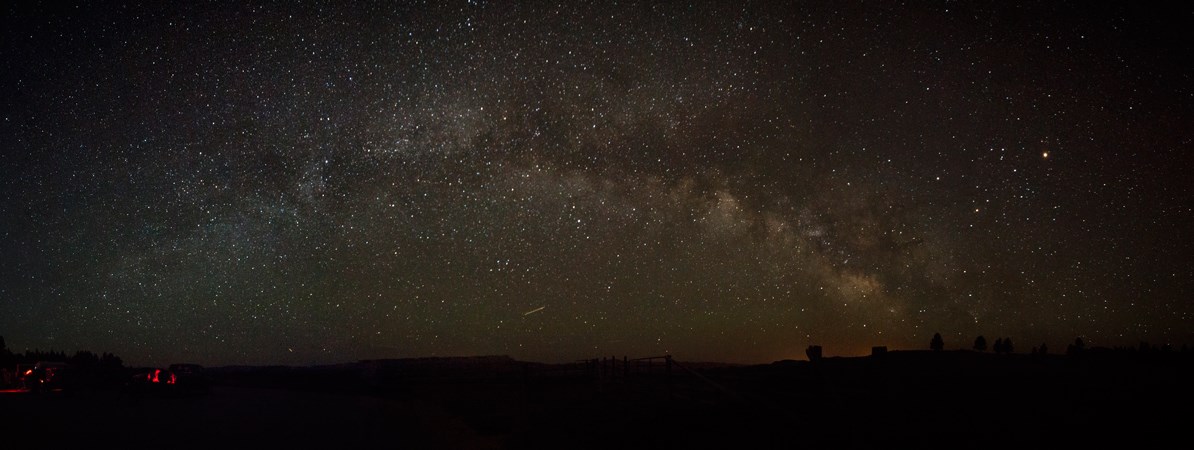
A Brief History of Astronomy at BryceJust how far can the eye see? On a typical stargazing night at Bryce Canyon, in Southwestern Utah, this is a question that has an ever-changing answer. At this park, there is an astronomy team whose members come from all over the country, many of whom bring their own telescope equipment and passion for the night. They give their time and expertise to share this ever precious resource with park visitors; on any given night they may be looking at Jupiter, 48 light minutes away, the ring nebula, 1500 light years away, or the Andromeda Galaxy, more than 2 million light years away… There seems to be present within all of us a deep and abiding connection to the stars. We look up, try to see the patterns, make up our own patterns and stories, and try to comprehend the vast distances the light traveled to reach us from faraway suns. It is important for us as a species to remember that we share a heritage with the stars; however, one resource, both natural and cultural, that many ignore or seldom consider is the beauty and darkness of the night sky. Two-thirds of Americans, those living in cities and suburbs, can no longer see the Milky Way from their own backyards and must seek it out elsewhere. At a truly dark location over 10,000 stars can be viewed over the course of a night and the Milky Way is perceived as a breath-taking band spanning the sky. But these places are becoming a rarity as light creeps its way across the United States and pollutes the purity of the night. Many national parks have begun to realize the need to preserve the black, untainted night sky for future generations of stargazers. They have begun to understand that a dark sky overhead is a treasure; even though it is intangible, it is just as precious as the earthly counterparts of canyons, pines, and clean rivers. Bryce Canyon National Park realized the importance of the night sky as a resource nearly four decades ago and as a result has become a leader in night sky protection and appreciation. At Bryce Canyon starlight spills out above the unique red rock formations called hoodoos. Here the sky is a piece of the park that is defended as fiercely as it’s fragile rock formations. Bryce Canyon’s astronomy program is thought to be the longest active astronomy program in the National Park Service. It began in 1969 when the Chief of Interpretation and Visitor Services added a night sky interpretation program to Bryce Canyon’s assortment of visitor offerings. Since its inception, there have been many seasonal and full time interpretive rangers who contributed to the growth of the night sky program with educational lectures, constellation tours, and stargazing. By 2001, Bryce Canyon’s skies had become so well known that the park began hosting an annual astronomy festival. By 2007, a team of 15 volunteers and 4 rangers ran the astronomy program from April to October. Although the rangers form the backbone of the program, it could not have reached its current success without the hard work of many volunteers. The work of the NPS Night Sky Team, a national program stationed at Bryce Canyon from 2004-2008, has also been integral in shaping the program’s attitude toward the conservation of one of the last great sanctuaries of darkness. This team works with numerous parks to measure and evaluate the effects of light pollution and educates park visitors and surrounding communities about the actions that individuals can take to protect and reclaim the night sky. After nearly forty years the program has reached a pinnacle of popularity; in 2006, over 27,000 visitors participated in various astronomy programs. Each night anywhere from 100 to 300 visitors gather around the telescopes to look up at their own place in the universe. Here, the National Park Service is proud to present, along with geological, biological, and historical programs, an astronomy program complete with its “Dark Rangers” who protect and share the other side of the park, the park at night, which holds a view just as precious as any that can be seen during the day. Truly, for every night this team operates, there are hundreds of visitors who marvel at the jeweled expanse overhead and who return to their respective homes and countries and think twice about the energy waste that outdoor lighting has created. For every child who listens attentively, there is a hope that he or she will understand and remember the sky of patterned stars and kindle the wonder of the incredible vastness of the universe in which we live. Timeline:
This information was compiled and edited by Claire Thoma, Chad Moore and Angie Richman |
Last updated: July 28, 2021
